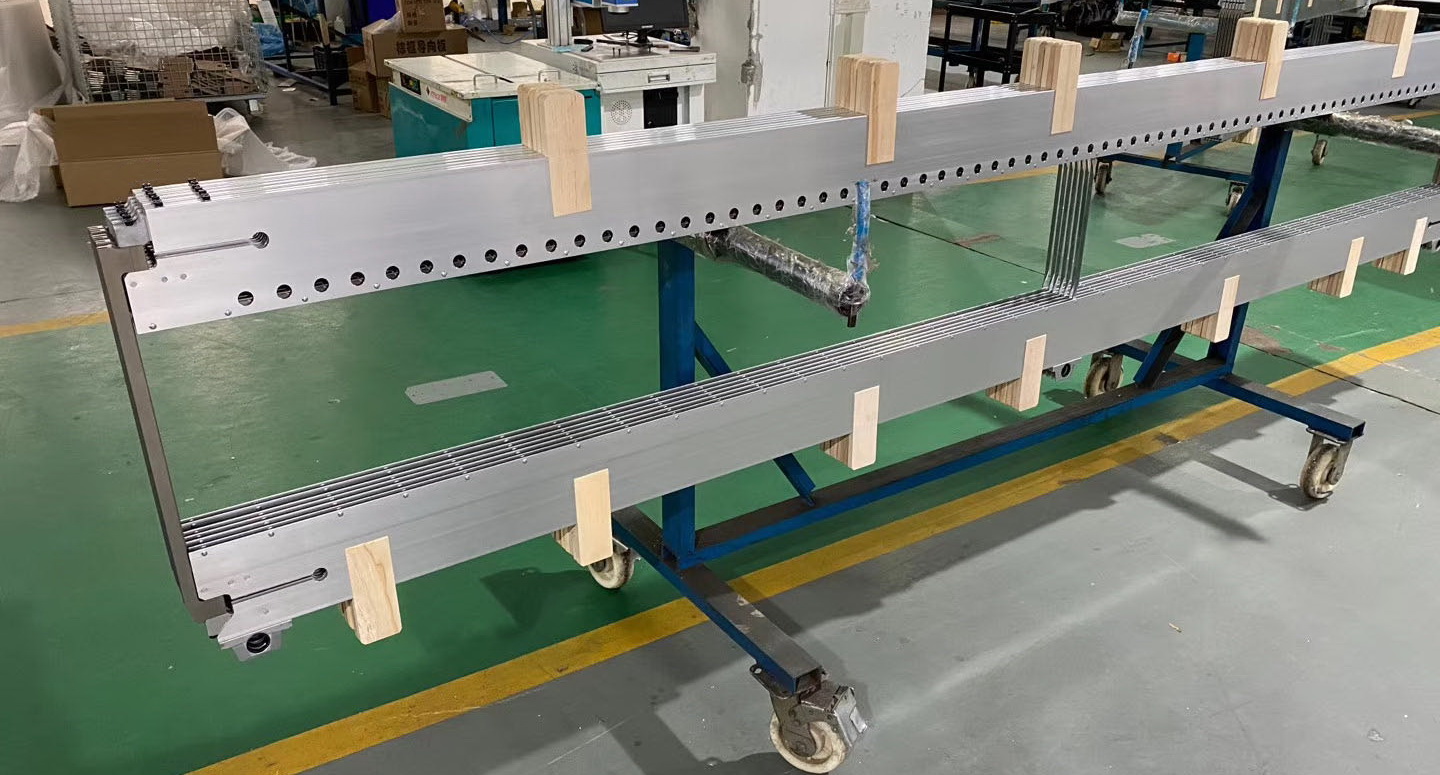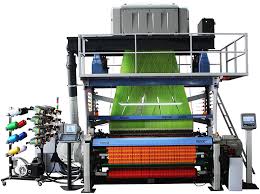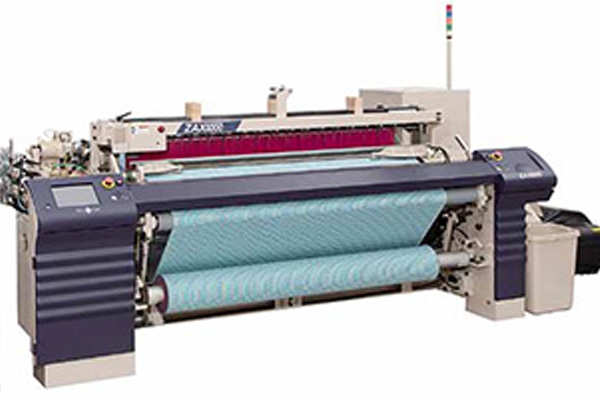Causes of Profile Reed Wearout and Measures for Extending Its Endurance
Weaving reed is one of the key equipments in textile weaving process. Its function is to push weft yarn into shedding and arrange warp yarn and weft yarn according to certain regularity and density in order to make the fabric reach the required weft density and width. Therefore, its performance is directly related to the quality of textile products, and plays a vital role in fabric quality. The reed dent is the smallest unit of reed. Each reed product is mainly fixed by a number of neatly arranged reed dents, fixed in the reed beam with reed adhesive, and then put into use after the adhesive solidifies. In this paper, the rational use of profiled reed in production is analyzed and discussed.
1. Classification of Weaving Reeds
Weaving reeds are generally classified into flat reeds and profile reeds according to their shapes. Flat reeds are mainly used in shuttle looms, projectile looms, rapier looms, water-jet looms and air-jet looms with confuser insertion, while profile reeds are used in air-jet looms with weft insertion by main and auxiliary nozzle relays, and air-jet looms with profile reed grooves.
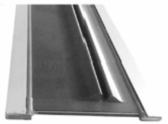
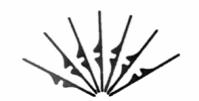
2. Causes of Weaving Reed Wearout
Warp and weft yarns are interwoven in the process of fabric formation, so there are warp and weft shrinkage. Before beating-up, the width of the cloth is smaller than that of the reed and the warp yarn tends to be inclined from top to bottom, and the inclination of both sides is more serious. In beating-up, the tension of the side warp is much greater than that of the middle warp, so the friction with the reed dents is very intense, and has longer the frictional length at the edge. At the same time, the beating-up force of the side reed dents is much greater than that of the middle reed dents. Because the yarn surface is not smooth, the warp sizing improves the wear resistance of the yarn, at the same time, the surface becomes more rough and tough, and the wearout of reed dent is aggravated. In the production of some kinds of fabrics, the beating-up force born by the edge reed dents is 12-17 times higher than the middle reed dents.
At present, the speed of air-jet loom is above 620-740 rpm, that is, the reciprocating friction and strike of profile reeds on yarns reaches 620-740 times per min, and there are about 80,000-96,000 reciprocating friction per day. Under such high frequency friction, it is unavoidable that grinding grooves appear in the profile reed dents. By observing the wearout of different types of profile reeds, it is found that when the vehicle speed is similar and the running time is the same, the fabrics with close weft density and warp density and fabrics with larger the weft shrinkage, the wearout of profile reeds tend to be more severe.
3. Measures for prolonging life of air jet loom reed
The price of profile reed is generally high. Once reed wear occurs in production, maintenance is needed, which not only affects the production efficiency, but also generate maintenance cost. Therefore, how to prolong the service life of reed and reduce the number of maintenance is of great economic benefit to textile enterprises.
3.1 Sawing off reed dent
When the reed is worn out, the left part of the reed teeth can be sawed off from the root of the teeth and the root burrs of the sawn part can be smoothed with a steel brush, and then the reed can be re-pressed. In the subsequent weaving process, the edge warp yarn has a certain displacement relative to the whole reed, thus reducing the encirclement angle between the warp yarn and reed teeth, which can meet the normal production needs.
3.2 Increase beating-up line
The gasket height under the support rods on both sides of the reed-piercing width and the outer side is increased and reduced periodically, so that the beating-up line at the knitting edge is increased from the original 1 to 2-5, so as to improve the service life of the reed.
3.3 Changing the local meridian line
When weaving fabrics, the beating-up yarn can be changed by installing the pick-up rod at the front pole of the warp stop or adjusting the height of the sling. This method can change one wear mark on reed teeth into several wear marks. It can effectively reduce the repair times of reed and improve production efficiency.
3.4 Reed dent maintenance
Reeds with worn reed teeth are removed from looms and sent to professional textile equipment factories for maintenance. Usually, the worn reed teeth on the special-shaped reed are removed, and the special reinforced reed teeth with a certain width are replaced. The repaired reed can be put back into weaving production.
3.5 Choosing new type of high wear-resisting reed
The hardness and wear-resistance of reed are improved by using new surface treatment technology. In the process of reed production, the most economical way is to apply new high wear-resistant material for about 200 dents on both sides of reed, which can increase the service life of reed by 2-3 times.
4. Surface Treatment of High Wear-Resisting Reed
4.1 DLC Surface Treatment
DLC (DIAMOND-LIKE CARBON), also known as diamond-like film, is fabricated by a physical vapor deposition technology. Its principle is that evaporated particles are deposited on the reed surface by arc discharge technology under vacuum (1.3×102-1.3×104Pa), and finally a deposition film is formed. The technology makes the film and reed have good bonding ability. The treated reed has high hardness, strong thermal shock resistance, oxidation resistance and good corrosion resistance. At present, some textile enterprises have begun to use DIC surface treatment reed dent. Its hardness is obviously higher than that of traditional reed dent. However, because of the high price, it has not been widely used, and it is mainly used in the edge of reed teeth in production to increase the wear resistance of edge reed dent to side yarn.
4.2 Surface treatment of polytetrafluoroethylene (PTFE)
Polytetrafluoroethylene (PTFE) is a relatively new surface treatment technology emerged in recent years. It immerses the reed in the polytetrafluoroethylene dipping solution as a whole, and after drying, it is heated to 327 ℃ and maintained for a certain period of time. The aim is to transform polymer molecules from crystalline to amorphous structure, so that dispersed single resin particles can form a continuous whole through mutual diffusion and melting. After cooling, the polymer molecule is transformed from amorphous structure to crystalline form. The surface lubrication degree of reed treated by this technology is obviously improved. During weaving, the wear of reed on warp yarn is smaller than that of traditional reed, and the mechanical properties of fabric are excellent.
4.3 Ceramic Surface Treatment
Ceramic surface treatment technology is to pre-treat the reed surface and then place it in a ceramic treatment container, controlling the working pressure of 2-5 MPa and the temperature of the container of 50-80℃. Therefore, the harder nano-ceramic material and the metal on the reed surface can be physic chemically interacted and embedded in the alloy coating of the reed surface to form a new strengthening layer. The surface hardness of reed dent treated by this technology is between 800-1000 HV, and the wear resistance is improved by more than 40%. It is a kind of surface treatment technology of reed dent, which is worth popularizing.
4.4 MAO Surface Treatment
Micro-arc oxidation technology is a new surface treatment technology developed in recent years. It combines electrolyte with certain electrical parameters to form anodic film on reed surface and at the same time the polarized film is transformed into ceramic film by micro arc instantaneous high temperature. This technology makes the treated reed dent have high hardness, good wear resistance and good toughness. At the same time, the film layer has strong bonding force with the reed matrix, corrosion resistance, high temperature oxidation resistance and good insulation. It is completely suitable for the high wear resistance and corrosion resistance requirements of reed dents in high-speed production process.
4.5 Particle Beam Enhanced Deposition Surface Treatment
This is a new method of surface hardness enhancement. In the process of surface hardness enhancement, high energy ion beam is used to bombard the reed surface to achieve the purpose of cleaning, and then evaporation is carried out to make the ions injected into the reed surface interacting with the deposited atoms, so that the atoms deposited on the reed surface can be decomposed. Thus, a uniform and compact film with stable performance can be obtained on the reed surface, and the modified thickness can be significantly increased.
4.6 Surface Ion Implantation
The reed dent is placed in the vacuum target chamber of ion implantation man-machine. Through the voltage action of tens to hundreds of kilovolts, the ions of Ti and N elements are accelerated and focused, and then injected into the surface of reed dent. Different structures such as supersaturated solid solution, metastable phase and amorphous state can be obtained, thus making reed hard degree, oxidation resistance, corrosion resistance, wear resistance and other properties have been significantly improved.
5. Conclusion
The quality of air jet loom reed directly affects the quality, production efficiency and cost of the fabric, so it is very important to prolong its life and maintain a good running state. The purpose of prolonging service life can be achieved by using and maintaining profile reeds well in production. However, with the development of textile machinery towards high speed, automation and intellectualization, the requirements of profile reeds performance are becoming higher and higher. The main influencing factors are material selection and surface coating technology of profile reed. Therefore, in order to comprehensively solve the problem of low service life of reed, it is of great significance to study the new surface treatment technology of reed dent and improve its wear-resistance.
1. Classification of Weaving Reeds
Weaving reeds are generally classified into flat reeds and profile reeds according to their shapes. Flat reeds are mainly used in shuttle looms, projectile looms, rapier looms, water-jet looms and air-jet looms with confuser insertion, while profile reeds are used in air-jet looms with weft insertion by main and auxiliary nozzle relays, and air-jet looms with profile reed grooves.

Profile Reed

Profile Reed Dent
2. Causes of Weaving Reed Wearout
Warp and weft yarns are interwoven in the process of fabric formation, so there are warp and weft shrinkage. Before beating-up, the width of the cloth is smaller than that of the reed and the warp yarn tends to be inclined from top to bottom, and the inclination of both sides is more serious. In beating-up, the tension of the side warp is much greater than that of the middle warp, so the friction with the reed dents is very intense, and has longer the frictional length at the edge. At the same time, the beating-up force of the side reed dents is much greater than that of the middle reed dents. Because the yarn surface is not smooth, the warp sizing improves the wear resistance of the yarn, at the same time, the surface becomes more rough and tough, and the wearout of reed dent is aggravated. In the production of some kinds of fabrics, the beating-up force born by the edge reed dents is 12-17 times higher than the middle reed dents.
At present, the speed of air-jet loom is above 620-740 rpm, that is, the reciprocating friction and strike of profile reeds on yarns reaches 620-740 times per min, and there are about 80,000-96,000 reciprocating friction per day. Under such high frequency friction, it is unavoidable that grinding grooves appear in the profile reed dents. By observing the wearout of different types of profile reeds, it is found that when the vehicle speed is similar and the running time is the same, the fabrics with close weft density and warp density and fabrics with larger the weft shrinkage, the wearout of profile reeds tend to be more severe.
3. Measures for prolonging life of air jet loom reed
The price of profile reed is generally high. Once reed wear occurs in production, maintenance is needed, which not only affects the production efficiency, but also generate maintenance cost. Therefore, how to prolong the service life of reed and reduce the number of maintenance is of great economic benefit to textile enterprises.
3.1 Sawing off reed dent
When the reed is worn out, the left part of the reed teeth can be sawed off from the root of the teeth and the root burrs of the sawn part can be smoothed with a steel brush, and then the reed can be re-pressed. In the subsequent weaving process, the edge warp yarn has a certain displacement relative to the whole reed, thus reducing the encirclement angle between the warp yarn and reed teeth, which can meet the normal production needs.
3.2 Increase beating-up line
The gasket height under the support rods on both sides of the reed-piercing width and the outer side is increased and reduced periodically, so that the beating-up line at the knitting edge is increased from the original 1 to 2-5, so as to improve the service life of the reed.
3.3 Changing the local meridian line
When weaving fabrics, the beating-up yarn can be changed by installing the pick-up rod at the front pole of the warp stop or adjusting the height of the sling. This method can change one wear mark on reed teeth into several wear marks. It can effectively reduce the repair times of reed and improve production efficiency.
3.4 Reed dent maintenance
Reeds with worn reed teeth are removed from looms and sent to professional textile equipment factories for maintenance. Usually, the worn reed teeth on the special-shaped reed are removed, and the special reinforced reed teeth with a certain width are replaced. The repaired reed can be put back into weaving production.
3.5 Choosing new type of high wear-resisting reed
The hardness and wear-resistance of reed are improved by using new surface treatment technology. In the process of reed production, the most economical way is to apply new high wear-resistant material for about 200 dents on both sides of reed, which can increase the service life of reed by 2-3 times.
4. Surface Treatment of High Wear-Resisting Reed
4.1 DLC Surface Treatment
DLC (DIAMOND-LIKE CARBON), also known as diamond-like film, is fabricated by a physical vapor deposition technology. Its principle is that evaporated particles are deposited on the reed surface by arc discharge technology under vacuum (1.3×102-1.3×104Pa), and finally a deposition film is formed. The technology makes the film and reed have good bonding ability. The treated reed has high hardness, strong thermal shock resistance, oxidation resistance and good corrosion resistance. At present, some textile enterprises have begun to use DIC surface treatment reed dent. Its hardness is obviously higher than that of traditional reed dent. However, because of the high price, it has not been widely used, and it is mainly used in the edge of reed teeth in production to increase the wear resistance of edge reed dent to side yarn.
4.2 Surface treatment of polytetrafluoroethylene (PTFE)
Polytetrafluoroethylene (PTFE) is a relatively new surface treatment technology emerged in recent years. It immerses the reed in the polytetrafluoroethylene dipping solution as a whole, and after drying, it is heated to 327 ℃ and maintained for a certain period of time. The aim is to transform polymer molecules from crystalline to amorphous structure, so that dispersed single resin particles can form a continuous whole through mutual diffusion and melting. After cooling, the polymer molecule is transformed from amorphous structure to crystalline form. The surface lubrication degree of reed treated by this technology is obviously improved. During weaving, the wear of reed on warp yarn is smaller than that of traditional reed, and the mechanical properties of fabric are excellent.
4.3 Ceramic Surface Treatment
Ceramic surface treatment technology is to pre-treat the reed surface and then place it in a ceramic treatment container, controlling the working pressure of 2-5 MPa and the temperature of the container of 50-80℃. Therefore, the harder nano-ceramic material and the metal on the reed surface can be physic chemically interacted and embedded in the alloy coating of the reed surface to form a new strengthening layer. The surface hardness of reed dent treated by this technology is between 800-1000 HV, and the wear resistance is improved by more than 40%. It is a kind of surface treatment technology of reed dent, which is worth popularizing.
4.4 MAO Surface Treatment
Micro-arc oxidation technology is a new surface treatment technology developed in recent years. It combines electrolyte with certain electrical parameters to form anodic film on reed surface and at the same time the polarized film is transformed into ceramic film by micro arc instantaneous high temperature. This technology makes the treated reed dent have high hardness, good wear resistance and good toughness. At the same time, the film layer has strong bonding force with the reed matrix, corrosion resistance, high temperature oxidation resistance and good insulation. It is completely suitable for the high wear resistance and corrosion resistance requirements of reed dents in high-speed production process.
4.5 Particle Beam Enhanced Deposition Surface Treatment
This is a new method of surface hardness enhancement. In the process of surface hardness enhancement, high energy ion beam is used to bombard the reed surface to achieve the purpose of cleaning, and then evaporation is carried out to make the ions injected into the reed surface interacting with the deposited atoms, so that the atoms deposited on the reed surface can be decomposed. Thus, a uniform and compact film with stable performance can be obtained on the reed surface, and the modified thickness can be significantly increased.
4.6 Surface Ion Implantation
The reed dent is placed in the vacuum target chamber of ion implantation man-machine. Through the voltage action of tens to hundreds of kilovolts, the ions of Ti and N elements are accelerated and focused, and then injected into the surface of reed dent. Different structures such as supersaturated solid solution, metastable phase and amorphous state can be obtained, thus making reed hard degree, oxidation resistance, corrosion resistance, wear resistance and other properties have been significantly improved.
5. Conclusion
The quality of air jet loom reed directly affects the quality, production efficiency and cost of the fabric, so it is very important to prolong its life and maintain a good running state. The purpose of prolonging service life can be achieved by using and maintaining profile reeds well in production. However, with the development of textile machinery towards high speed, automation and intellectualization, the requirements of profile reeds performance are becoming higher and higher. The main influencing factors are material selection and surface coating technology of profile reed. Therefore, in order to comprehensively solve the problem of low service life of reed, it is of great significance to study the new surface treatment technology of reed dent and improve its wear-resistance.

 English
English  한국어
한국어  português
português  العربية
العربية  tiếng việt
tiếng việt  ไทย
ไทย  Malay
Malay  हिंदी
हिंदी  Indonesia
Indonesia  বাঙালি
বাঙালি  اردو
اردو 
